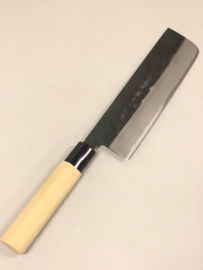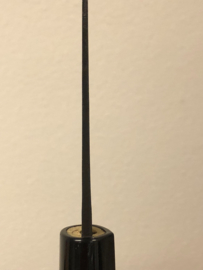-38%
Kajiwara Nakiri Jigata (Vegetable knife), 165 mm
Kajiwara Nakiri Jigata, 165 cm
This Japanese vegetable knife has a core of Japanese Aogami carbon steel with a protective layer (Sanmai) on the outside. This double-sided sharpened knife is provided with a black (Kurochi) protective layer. This knife is completely hand-forged by the masters Tsutomu Kajiwara from Tosa and is unique in its kind. The blade is very thin and manually sharpened and has no thickenings which makes sharpening very easy.
- Blade length: 165 mm
- Total length: 315 mm
- Weight: 150 grams
- Steel type: core steel: Japanese Aogami # 2 steel "Blue paper steel" (non-stainless) with 2 layers of softer steel on the outside and black Kurochi protective coating.
- Hardness: 62 (Rockwell C)
- Handle: D-shaped Honoki wood and black plastic bolster (only suitable for right-handed use)
Like all Japanese knives, Kajiwara's handmade knives are not dishwasher-proof, after each use cleaning and drying is the best treatment for these exclusive products. There are no wooden sayas available for this knife.
Cutting techniques for a nakiri
Chopping vegetables with a nakiri is a cutting technique that is mainly used for leafy vegetables, herbs and softer vegetables (such as cucumber, mushroom, zucchini and gherkin). The technique is characterized by the knife being completely detached from the cutting board during cutting. Chopping is always done at high speed. The technique requires a lot of practice and a razor-sharp knife.
- Stand straight in front of the cutting board, firmly on 2 legs with the shoulders backwards.
- Hold the knife as if you were giving someone a hand.
- Keep the knife when cutting in the extension of your forearm.
- Let the knife go straight down during cutting.
- Then move the knife along the finger joints of the non-intersecting hand.
- Cut quickly and pull the fingers back evenly so that the slices are just as thick.
When chopping leafy vegetables and herbs, first roll up the leaves into a kind of cigar. You can then cut these into very fine strips. If you mention a recipe that meat or fish must be chased, it is not the intention to cut them fine. With chopping, in that case the superficial scoring of the meat or the fish is meant. With fish, the fish is prevented from warping or the skin bursts ugly. Meat is cut to promote the yarn and prevent shrinking.






